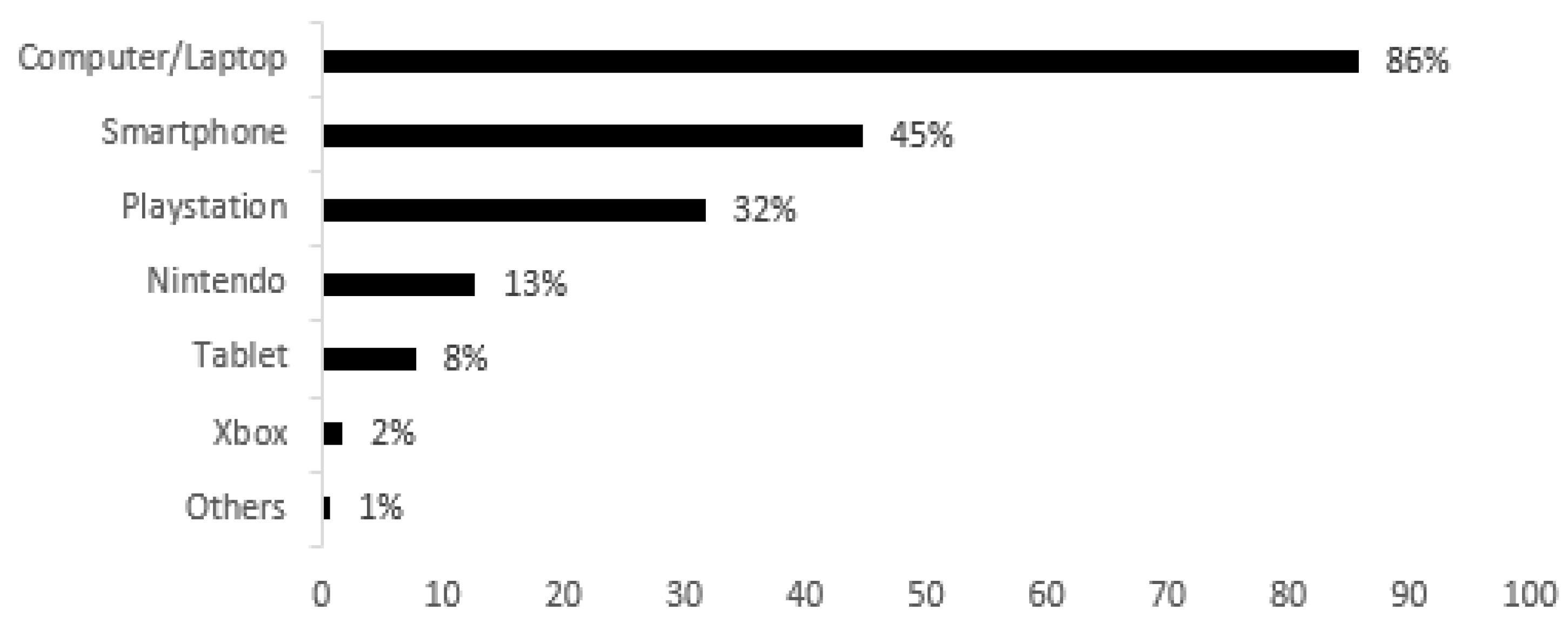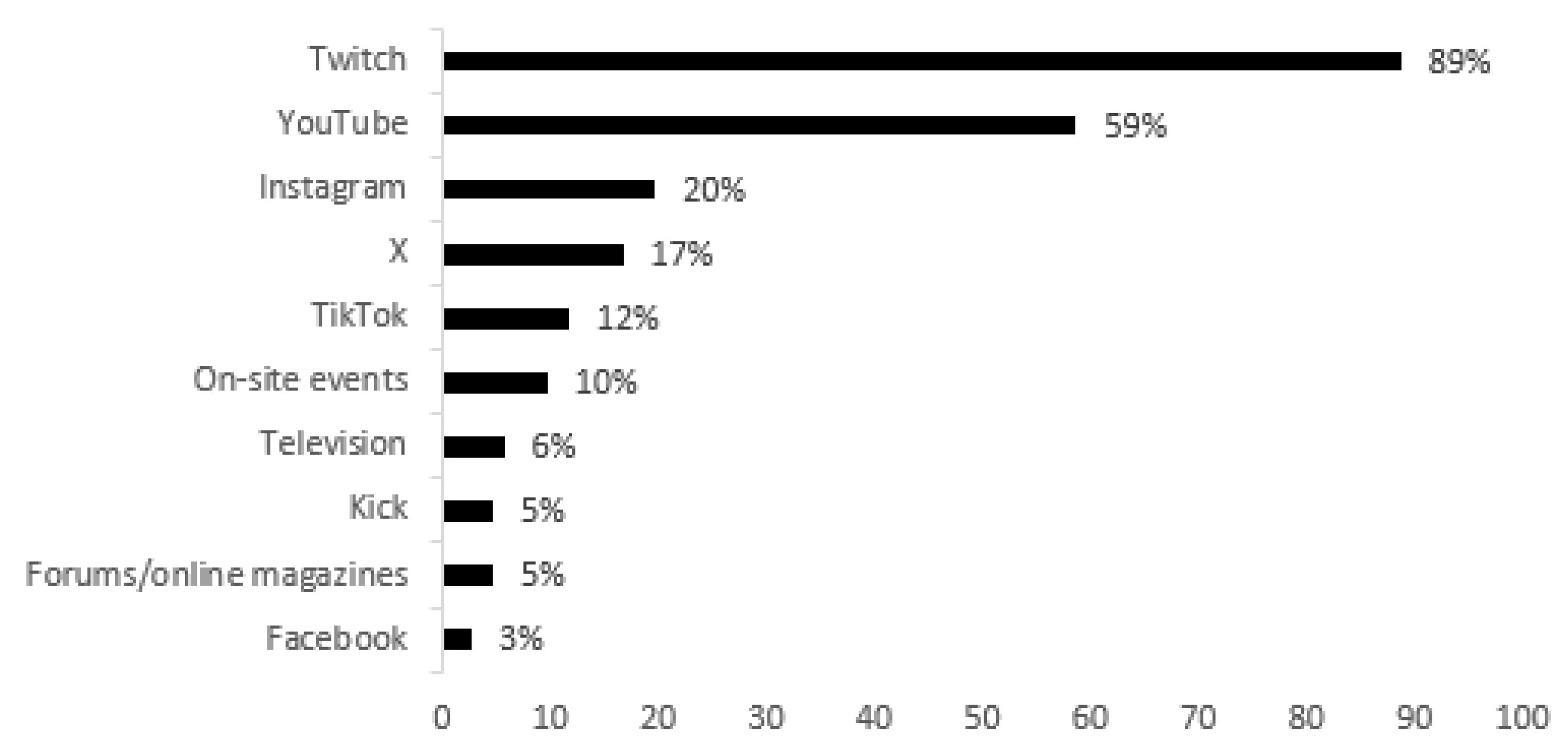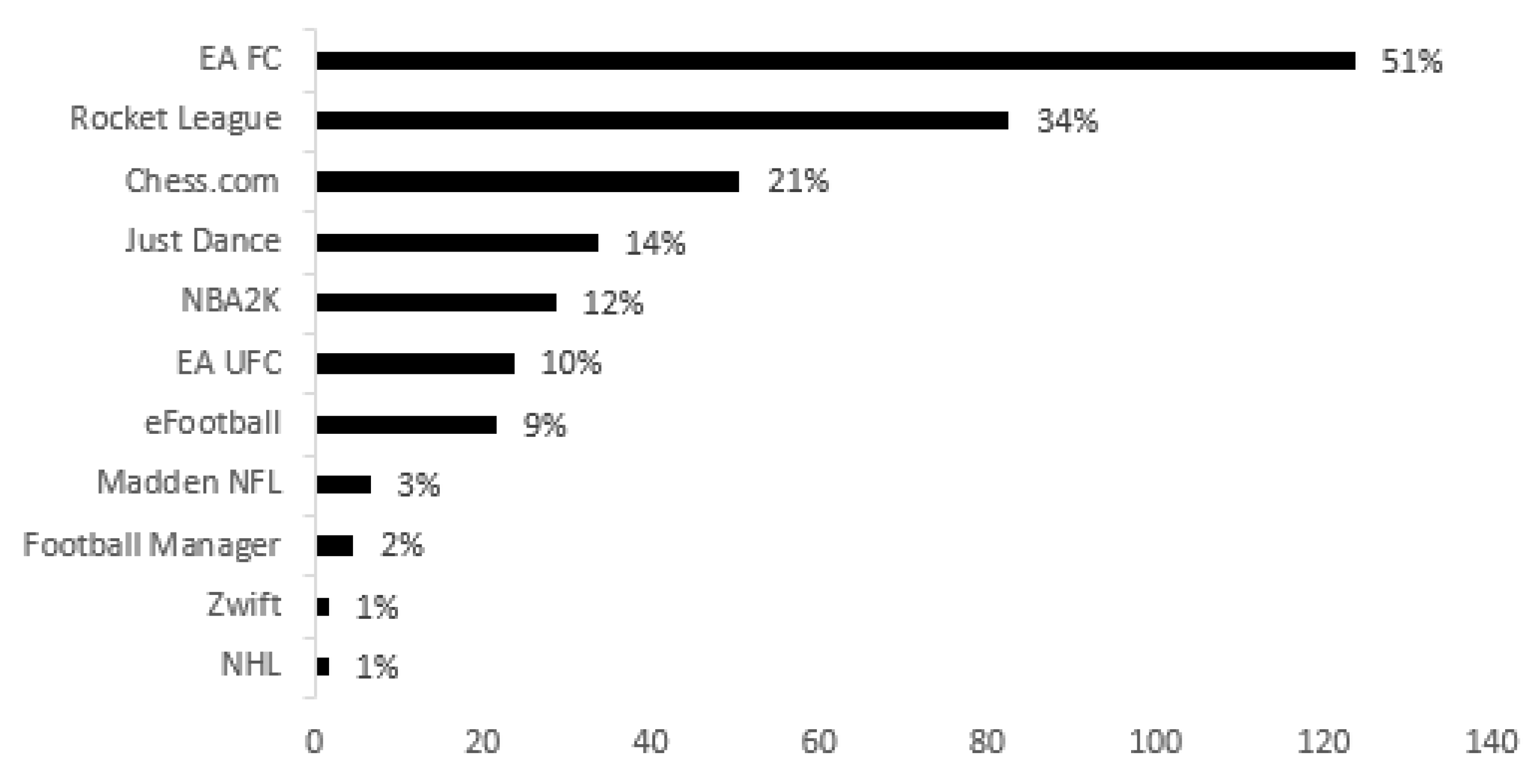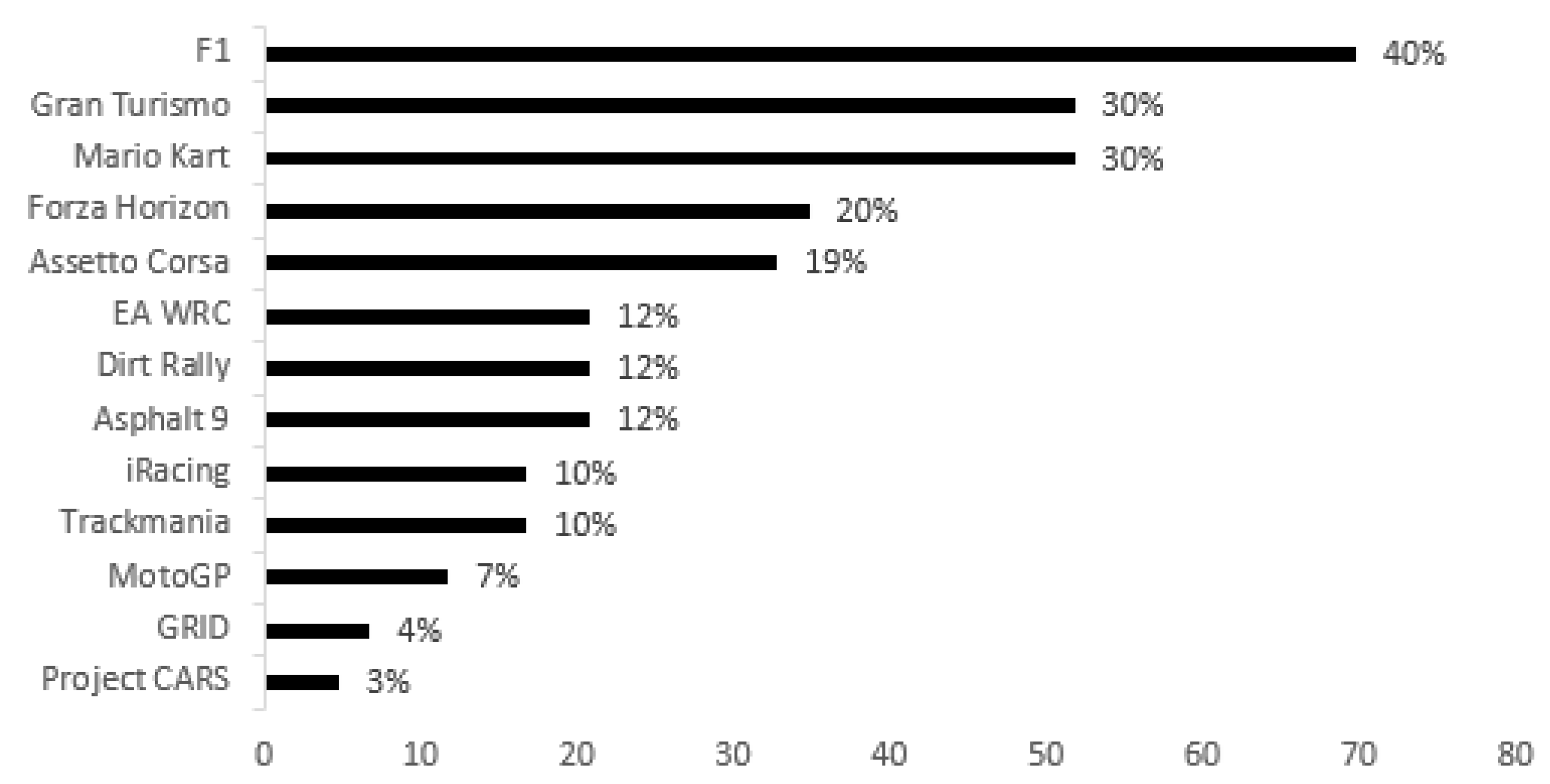Gaming Habits in Esports: An Exploratory Approach Among University Student Gamers in Europe
Abstract
1. Introduction
2. Materials and Methods
2.1. Research Design and Participants
2.2. Data Collection
2.3. Instrument
2.4. Data Analysis
3. Results
3.1. Sociodemographic Profile
3.2. General Practices and Consumption of Gaming
3.3. University Esports: Knowledge, Practice and Consumption
4. Discussion
5. Conclusions
6. Limitations and Future Research
Author Contributions
Funding
Institutional Review Board Statement
Informed Consent Statement
Data Availability Statement
Conflicts of Interest
References
- Adachi, P., & Willoughby, T. (2017). The link between playing video games and positive youth outcomes. Child Development Perspectives, 11(3), 202–206. [Google Scholar] [CrossRef]
- Baltezarević, R., & Baltezarević, B. (2018). The impact of video games on the formation of esports. Facta Universitatis Series: Physical Education & Sport, 16(1), 137–147. [Google Scholar] [CrossRef]
- Baumann, A., Mentzoni, R., Erevik, E., & Pallesen, S. (2022). A qualitative study on Norwegian esports students’ sleep, nutritional and physical activity habits and the link to health and performance. Available online: https://www.ijesports.org/article/88/html (accessed on 20 April 2025).
- Białecki, A., Xenopoulos, P., Dobrowolski, P., Białecki, R., & Gajewski, J. (2024). ESPORT: Electronic sports professionals observations and reflections on training. Physical Culture and Sport. Studies and Research, 105, 13–23. [Google Scholar] [CrossRef]
- Burroughs, B., & Rama, P. (2015). The esports trojan horse: Twitch and streaming futures. Journal of Virtual Worlds Research, 8(2), 1–5. [Google Scholar] [CrossRef]
- Ceballos-Medina, O. (2024). The practice of eSports in university students. Sponsorships and streaming. Cuadernos de Psicología del Deporte, 24(2), 231–241. [Google Scholar] [CrossRef]
- Cheng, M., Chen, L., Pan, Q., Gao, Y., & Li, J. (2023). E−sports playing and its relation to lifestyle behaviors and psychological well-being: A large-scale study of collegiate e-sports players in China. Complementary Therapies in Clinical Practice, 51, 101731. [Google Scholar] [CrossRef]
- Choi, W., Jang, W., Song, H., Kim, M., Lee, W., & Byon, K. (2024). Esports for development? Exploring esports player profiles and their development and well-being outcomes. International Journal of Sports Marketing and Sponsorship, 25(3), 684–704. [Google Scholar] [CrossRef]
- Chou, S., Jang, W., Ma, S., Chang, C., & Byon, K. (2023). Is mobile gaming a new pillar of esports? Exploring players’ in-game purchases in PC and mobile platforms by using flow and clutch. International Journal of Sports Marketing and Sponsorship, 24(2), 311–332. [Google Scholar] [CrossRef]
- Darvin, L., Vooris, R., & Mahoney, T. (2020). The playing experiences of esports participants: Na analysis of hostility and treatment discrimination in esports environments. Journal of Athlete Development and Experience, 2(1), 36–50. [Google Scholar] [CrossRef]
- Delello, J., McWhorter, R., Roberts, P., De Giuseppe, T., & Corona, F. (2023). The risks and rewards of collegiate esports: A multi-case study of gamers in the United States and Italy. International Journal of Gaming and Computer-Mediated Simulations, 15(1), 1–22. [Google Scholar] [CrossRef]
- Delello, J., McWhorter, R., Yoo, S., Roberts, P., & Adele, B. (2025). The impact of esports on the habits, health, and wellness of the collegiate player. Journal of Intercollegiate Sport, 18(1), 1–22. [Google Scholar] [CrossRef]
- Eickhoff, E., Yung, K., Davis, D. L., Bishop, F., Klam, W., & Doan, A. (2015). Excessive video game use, sleep deprivation, and poor work performance among US Marines treated in a military mental health clinic: A case series. Military Medicine, 180(7), 839–843. [Google Scholar] [CrossRef] [PubMed]
- EspoWorld. (2020). Format wars: Online vs. LAN. medium. Available online: https://espoworld.medium.com/format-wars-online-vs-lan-51ef80b53508 (accessed on 4 September 2023).
- Fromme, J. (2003). Computer games as a part of children’s culture. Game Studies, 3(1), 1–23. Available online: https://gamestudies.org/0301/fromme/ (accessed on 4 September 2023).
- Funk, D., Pizzo, A., & Baker, B. (2018). eSport management: Embracing eSport education and research opportunities. Sport Management Review, 21(1), 7–13. [Google Scholar] [CrossRef]
- García, J., & Murillo, C. (2020). Sports video games participation: What can we learn for esports? Sport, Business and Management, 10(2), 169–185. [Google Scholar] [CrossRef]
- González-Bueso, V., Santamaría, J., Fernández, D., Merino, L., Montero, E., & Ribas, J. (2018). Association between internet gaming disorder or pathological video-game use and comorbid psychopathology: A comprehensive review. International Journal of Environmental Research and Public Health, 15(4), 668. [Google Scholar] [CrossRef]
- Goño, P. (2023). Female esports hits new viewership records for valorant & MLBB. Available online: https://escharts.com/news/female-esports-2023 (accessed on 3 January 2024).
- Goño, P. (2024). Esports Trends 2024—Saudi Arabia future prospects, mobile gaming expansion and more. Available online: https://escharts.com/news/esports-trends-2024 (accessed on 28 January 2024).
- Granic, I., Lobel, A., & Engels, R. (2014). The benefits of playing video games. The American Psychologist, 69(1), 66–78. [Google Scholar] [CrossRef]
- Hallmann, K., & Giel, T. (2018). eSports–Competitive sports or recreational activity? Sport Management Review, 21(1), 14–20. [Google Scholar] [CrossRef]
- Hamari, J., & Sjöblom, M. (2017). What is esports and why do people watch it? Internet Research, 27(2), 211–232. [Google Scholar] [CrossRef]
- Hedlund, D. (2021). A typology of esport players. Journal of Global Sport Management, 8(2), 460–477. [Google Scholar] [CrossRef]
- Hilvoorde, I., & Pot, N. (2016). Embodiment and fundamental motor skills in Esports. Sport, Ethics and Philosophy, 10(1), 14–27. [Google Scholar] [CrossRef]
- Hosmer, D., Lemeshow, S., & Sturdivant, R. (2013). Applied logistic regression. John Wiley & Sons. [Google Scholar] [CrossRef]
- Hwang, J., & Kim, J. (2022). Exploring college students’ perceptions of esports and esports academic programs. Sport Management Education Journal, 17(1), 29–39. [Google Scholar] [CrossRef]
- Jenny, S., Gawrysiak, J., & Besombes, N. (2021). Esports.edu: An inventory and analysis of global higher education esports academic programming and curricula. International Journal of Esports. Available online: https://www.ijesports.org/article/59/html (accessed on 21 April 2025).
- Jenny, S., Keiper, M., Taylor, B., Williams, D., Gawrysiak, J., Manning, R., & Tutka, P. (2018). eSports venues: A new sport business opportunity. Journal of Applied Sport Management, 10(1), 34–39. [Google Scholar] [CrossRef]
- Jonasson, K., & Thiborg, J. (2010). Electronic sport and its impact on future sport. Sport in Society, 13(2), 287–299. [Google Scholar] [CrossRef]
- Kauweloa, N., & Winter, J. (2019). Taking college esports seriously. Loading, 12(20), 35–50. [Google Scholar] [CrossRef]
- Kawabe, K., Horiuchi, F., Hosokawa, R., Nakachi, K., Soga, J., & Ueno, S. (2022). Influence of an esports program on problematic gaming in children with autistic spectrum disorder: A pilot study. Behavioral Sciences, 12(6), 172. [Google Scholar] [CrossRef] [PubMed]
- Ke, X., & Wagner, C. (2020). Global pandemic compels sport to move to esports: Understanding from brand extension perspective. Managing Sport and Leisure, 27(1–2), 152–157. [Google Scholar] [CrossRef]
- Keiper, M., Manning, R., Jenny, S., Olrich, T., & Croft, C. (2017). No reason to LoL at LoL: The addition of esports to intercollegiate athletic departments. Journal for the Study of Sports and Athletes in Education, 11(2), 143–160. [Google Scholar] [CrossRef]
- Kim, K., Kim, M., Han, J., Kim, D., & Lee, I. (2022). Does “we” matter for esports fans? Analyzing the mediating effects of the sense of fan community on team identification and fandom behaviors. Physical Culture and Sport. Studies and Research, 97(1), 65–76. [Google Scholar] [CrossRef]
- Koskimaa, R. (2024). Esports culture in Europe. Routledge. [Google Scholar]
- Lehnert, K., Walz, A., & Christianson, R. (2020). The booming eSports market: A field day for fans. Journal of Business Strategy, 43(2), 122–128. [Google Scholar] [CrossRef]
- Lemeshow, S., & Hosmer, D. (1982). A review of goodness of fit statistics for use in the development of logistic regression models. American Journal of Epidemiology, 115(1), 92–106. [Google Scholar] [CrossRef]
- Lo, C. (2022). Defining esports student-athletes and the behaviors that affect academic performance. University of Wisconsin-Stout Journal of Student Research, 20, 31–42. Available online: https://minds.wisconsin.edu/handle/1793/83393 (accessed on 22 April 2025).
- López-Carril, S., Añó, V., & Villamón, M. (2019). The academic field of sport management: Past, present and future. Cultura, Ciencia y Deporte, 14(42), 277–287. [Google Scholar] [CrossRef]
- Luo, X., & Chen, L. (2024). Sex differences and cultural diversity in perceptions toward eSports between American and Chinese university students. Cogent Social Sciences, 10(1), 2399932. [Google Scholar] [CrossRef]
- Ma, S., Byon, K., Jang, W., Ma, S., & Huang, T. (2021). Esports spectating motives and streaming consumption: Moderating effect of game genres and live-streaming types. Sustainability, 13(8), 4164. [Google Scholar] [CrossRef]
- Martončik, M. (2015). e-Sports: Playing just for fun or playing to satisfy life goals? Computers in Human Behavior, 48, 208–211. [Google Scholar] [CrossRef]
- McGrath, K. (2019). Leveraging eSports in higher education. In R. Rogers (Ed.), Understanding esports: An introduction to the global phenomenon (pp. 201–218). Lexington Books. [Google Scholar]
- Meng-Lewis, Y., Wong, D., & Liu, C. (2024). The emergent community of esports fans in Japan: An analysis of motivations and preferences. Managing Sport and Leisure, 1–32. [Google Scholar] [CrossRef]
- Newman, J., Xue, H., Watanabe, N., Yan, G., & McLeod, C. (2022). Gaming gone viral: An analysis of the emerging esports narrative economy. Communication & Sport, 10(2), 241–270. [Google Scholar] [CrossRef]
- Newman, M., & Vanderhoef, J. (2023). Masculinity. In M. Wolf, & B. Perron (Eds.), The Routledge companion to video game studies. Routledge. [Google Scholar] [CrossRef]
- Newzoo. (2024a). Global games market report 2023. Available online: https://newzoo.com/resources/trend-reports/newzoo-global-games-market-report-2023-free-version (accessed on 3 July 2024).
- Newzoo. (2024b). How consumers engage with games today. Available online: https://newzoo.com/resources/trend-reports/global-gamer-study-free-report-2024 (accessed on 3 July 2024).
- Oh, T., Kang, J.-H., Lee, Y., & Choi, S. M. (2024). Comparison of audience behavior between esports and authentic sports fans. Behavioral Sciences, 14(4), 313. [Google Scholar] [CrossRef]
- Örsoğlu, T., Yüzbaşıoğlu, B., & Pekel, H. (2023). eSports: Digital games and its future from the traditional athletes’ and esports players’ perspectives. Simulation & Gaming, 54(5), 534–553. [Google Scholar] [CrossRef]
- Palanichamy, T., Sharma, M., Sahu, M., & Kanchana, D. (2020). Influence of Esports on stress: A systematic review. Industrial Psychiatry Journal, 29(2), 191–199. [Google Scholar] [CrossRef] [PubMed]
- Peng, Q., Dickson, G., Scelles, N., Grix, J., & Brannagan, P. (2020). Esports governance: Exploring stakeholder dynamics. Sustainability, 12(19), 8270. [Google Scholar] [CrossRef]
- Perrin, A. (2018). 5 facts about Americans and video games. Pew Research Center. Available online: https://www.pewresearch.org/short-reads/2018/09/17/5-facts-about-americans-and-video-games/ (accessed on 3 July 2024).
- Picamilho, S., Saragoça, J., & Teixeira, M. (2021). Dual careers in high sporting performance in Europe: A systematic literature review. Motricidade, 17(3), 290–305. [Google Scholar] [CrossRef]
- Picamilho, S., Saragoça, J., & Teixeira, M. (2023). Exploratory factor analysis of instruments for dual career assessment. Motricidade, 19(4), 451–467. [Google Scholar] [CrossRef]
- Pluss, M., Novak, A., Bennett, K., McBride, I., Panchuk, D., Coutts, A., & Fransen, J. (2022). Examining the game-specific practice behaviors of professional and semi-professional esports players: A 52-week longitudinal study. Computers in Human Behavior, 137, 107421. [Google Scholar] [CrossRef]
- Poulus, D., Sargeant, J., Zarate, D., Griffiths, M., & Stavropoulos, V. (2024). Burnout profiles among esports players: Associations with mental toughness and resilience. Journal of Sports Sciences, 42(18), 1685–1694. [Google Scholar] [CrossRef]
- Pu, H., Kim, J., & Daprano, C. (2021). Can esports substitute traditional sports? The convergence of sports and video gaming during the pandemic and beyond. Societies, 11(4), 129. [Google Scholar] [CrossRef]
- Reitman, J., Anderson-Coto, M., Wu, M., Lee, J., & Steinkuehler, C. (2020). Esports research: A literature review. Games and Culture, 15(1), 32–50. [Google Scholar] [CrossRef]
- Ribeiro, T., Almeida, V., Calapez, A., Matsuoka, H., & Yamashita, R. (2023). Esports and Olympic games: A cross-cultural exploration of the player support behaviour towards the Olympics. International Journal of Sports Marketing and Sponsorship, 24(4), 700–721. [Google Scholar] [CrossRef]
- Richard, G., McKinley, Z., & Ashley, R. (2019). Collegiate esports as learning ecologies: Investigating collaboration, reflection and cognition during competitions. Transactions of the Digital Games Research Association, 4(3). [Google Scholar] [CrossRef]
- Rogstad, E. (2021). Gender in eSports research: A literature review. European Journal of Sport and Society, 19(3), 195–213. [Google Scholar] [CrossRef]
- Rudolf, K., Bickmann, P., Froböse, I., Tholl, C., Wechsler, K., & Grieben, C. (2020). Demographics and health behavior of video game and eSports players in Germany: The eSports study 2019. International Journal of Environmental Research and Public Health, 17(6), 1870. [Google Scholar] [CrossRef] [PubMed]
- Saiz-Alvarez, J., Palma-Ruiz, J., Valles-Baca, H., & Fierro-Ramírez, L. (2019). Knowledge management in the esports industry: Sustainability, continuity, and achievement of competitive results. Sustainability, 13(19), 10890. [Google Scholar] [CrossRef]
- Scolari, C. A., Pires, F., & Masanet, M. (2022). Gamers never play alone: An interface-centred analysis of online video gaming. First Monday, 27(1–3). [Google Scholar] [CrossRef]
- Sesinando, A., Segui-Urbaneja, J., & Teixeira, M. (2022). Professional development, skills, and competences in sports: A survey in the field of sport management among public managers. Journal of Physical Education and Sport, 22(11), 2800–2809. [Google Scholar] [CrossRef]
- Sesinando, A., Segui-Urbaneja, J., & Teixeira, M. (2023). Leadership styles in sports management: Concepts and practical implications at local government level. Atena Editora. [Google Scholar] [CrossRef]
- Shen, Y., & Cicchella, A. (2023). Health consequences of intensive E-gaming: A systematic review. International Journal of Environmental Research and Public Health, 20(3), 1968. [Google Scholar] [CrossRef]
- Shulze, J., Marquez, M., & Ruvalcaba, O. (2021). The biopsychosocial factors that impact esports players’ well-being: A systematic review. Journal of Global Sport Management, 8(2), 478–502. [Google Scholar] [CrossRef]
- Teixeira, M., Banza, T., Almeida, N., & Sesinando, A. (2023a). Motivations and expectations of Olympic volunteers: Building a legacy of personal development as a key factor for the success of sports mega-events. Physical Culture and Sport. Studies and Research, 102(1), 1–18. [Google Scholar] [CrossRef]
- Teixeira, M., Júnior, A., & Sesinando, A. (2023b). Sport events as a catalyst for economic, socio-cultural, tourism, and environmental sustainability in Portugal. In G. Cepeda-Carrión, J. Garcia-Fernández, & J. J. Zhang (Eds.), Sport management in the Ibero-American world: Product and service innovations (pp. 258–273). Routledge. [Google Scholar] [CrossRef]
- Teixeira, M., Mamede, N., Seguí-Urbaneja, J., & Sesinando, A. (2023c). European cities of sport as a strategic policy for local development of sports: A perspective from sports management in the last decade. Physical Culture and Sport. Studies and Research, 103(1), 28–43. [Google Scholar] [CrossRef]
- Teixeira, M., Rijo, V., & Sesinando, A. (2022). Sports management research: Analysis of scientific development in Portugal (2008–2017). Journal of Physical Education, 33(1), e-3353. [Google Scholar] [CrossRef]
- Tham, S., & Kelling, K. (2023). The dynamics of problematic gaming in e-sports through the lens of FIFA gaming. Addiction Research & Theory, 32(4), 282–290. [Google Scholar] [CrossRef]
- Thiel, A., & John, J. (2019). Is eSport a ‘real’sport? Reflections on the spread of virtual competitions. European Journal for Sport and Society, 15(4), 311–315. [Google Scholar] [CrossRef]
- Todt, N., Pase, A., Scarton, A., Rolim, L., Berlitz, G., & Baptista, L. (2020). The esports and Olympic games: Perspectives of an ongoing debate. Journal of Human Sport and Exercise, 15(1), 94–110. [Google Scholar] [CrossRef]
- Trotter, M., Coulter, T., Davis, P., Poulus, D., & Remco, P. (2022). Examining the impact of school esports program participation on student health and psychological development. Frontiers in Psychology, 12, 807341. [Google Scholar] [CrossRef]
- Urbaneja, J., Mendonça, C., & Teixeira, M. (2023). The Portuguese gamer: Characterization and sports habit (gender perspective). Retos, 47, 352–358. [Google Scholar] [CrossRef]
- Wagner, M. (2006, June 26–29). On the scientific relevance of eSport. 2006 International Conference on Internet Computing and Conference on Computer Game Development (ICOMP), Las Vegas, NV, USA. Available online: https://www.researchgate.net/publication/220968200_On_the_Scientific_Relevance_of_eSports (accessed on 5 September 2024).
- Yamanaka, G., Campos, M., Roble, O., & Mazzei, L. (2021). eSport: A state-of-the-art review based on bibliometric analysis. Journal of Physical Education and Sport, 21(6), 3547–3555. [Google Scholar] [CrossRef]
- Yin, C., Huang, Y., Kim, D., & Kim, K. (2023). The effect of esports content attributes on viewing flow and well-being: A focus on the moderating effect of esports involvement. Sustainability, 15(16), 12207. [Google Scholar] [CrossRef]
- Zagala, K., & Strzelecki, A. (2019). eSports evolution in football game series. Physical culture and sport. Studies and Research, 83(1), 54–66. [Google Scholar] [CrossRef]
- Zhao, G., Cheng, Y., Liu, X., & Meng, W. (2022). Sustaining esports industry and regulatory focus: Empirical evidence from Chinese universities. Frontiers in Psychology, 13, 907050. [Google Scholar] [CrossRef]
- Zhong, Y., Guo, K., Su, J., & Chu, S. (2022). The impact of esports participation on the development of 21st century skills in youth: A systematic review. Computers & Education, 191, 104640. [Google Scholar] [CrossRef]




| N | % | |
|---|---|---|
| Gender | ||
| Male | 770 | 71.8 |
| Female | 303 | 28.2 |
| Total | 1073 | 100.0 |
| Age range (by group) | ||
| 17–19 | 236 | 22.0 |
| 20–24 | 730 | 68.0 |
| 25–29 | 75 | 7.0 |
| 30 and over | 32 | 3.0 |
| Total | 1073 | 100.0 |
| Age group (by gender) | ||
| Male | ||
| 17–19 | 162 | 21.0 |
| 20–24 | 512 | 66.5 |
| 25–29 | 71 | 9.2 |
| 30 and over | 25 | 3.3 |
| Subtotal | (770) | (100) |
| Female | ||
| 17–19 | 75 | 24.8 |
| 20–24 | 196 | 64.7 |
| 25–29 | 23 | 7.6 |
| 30 and over | 9 | 2.9 |
| Subtotal | (303) | (100.0) |
| Total | 1073 | 100.0 |
| Study cycle | ||
| Undergraduate degree | 848 | 79.0 |
| Integrated master’s degree | 53 | 5.0 |
| Master’s degree | 172 | 16.0 |
| Total | 1073 | 100.0 |
| N | % | |
|---|---|---|
| Age of first contact with gaming (by group) | ||
| 2–6 | 305 | 28.4 |
| 7–11 | 495 | 46.1 |
| 12–16 | 249 | 23.2 |
| 17 and over | 12 | 1.1 |
| Total | 1073 | 100.0 |
| Gaming practice (global) | ||
| Once a week | 86 | 8.0 |
| A few times a week | 472 | 44.0 |
| Daily | 515 | 48.0 |
| Total | 1073 | 100.0 |
| Gaming practice (by gender) | ||
| Male | ||
| Once a week | 51 | 6.6 |
| A few times a week | 313 | 40.6 |
| Daily | 406 | 52.8 |
| Subtotal | (770) | (100.0) |
| Female | ||
| Once a week | 33 | 10.8 |
| A few times a week | 163 | 53.9 |
| Daily | 107 | 35.3 |
| Subtotal | (303) | (100.0) |
| Total | 1073 | 100.0 |
| Gaming hours per week | ||
| Between 1 and 5 h | 290 | 27.0 |
| Between 6 and 10 h | 322 | 30.0 |
| Between 11 and 15 h | 150 | 14.0 |
| Between 16 and 20 h | 129 | 12.0 |
| Between 21 and 30 h | 118 | 11.0 |
| 30 h and over | 64 | 6.0 |
| Total | 1073 | 100.0 |
| Categories of Videogames | Male (n = 770) | Female (n = 303) | ||
|---|---|---|---|---|
| N | % | N | % | |
| First-person shooter (FPS) | 529 | 68.7 | 141 | 46.5 |
| Battle Royale (BR) | 283 | 36.8 | 136 | 44.9 |
| Multiplayer Online Battle Arena (MOBA) | 294 | 38.2 | 89 | 29.4 |
| Sports Games (SGs) | 320 | 41.5 | 55 | 18.2 |
| Real-time strategy (RTS) | 272 | 35.3 | 73 | 24.1 |
| Racing Games (RGs) | 207 | 26.9 | 75 | 24.8 |
| Fighting Games (FGs) | 143 | 18.6 | 54 | 17.8 |
| Collectible Card Games (CCGs) | 104 | 13.5 | 26 | 8.6 |
| Others | 246 | 31.9 | 160 | 52.8 |
| Categories of Videogames | Esports Games Played (n = 1073) | University Esports Games Planned to Be Played (n = 579) | ||
|---|---|---|---|---|
| Ordering | % | Ordering | % | |
| FPS | 1st | 64.0 | 1st | 70.0 |
| Battle Royale | 2nd | 40.0 | 4th | 34.0 |
| MOBA | 3rd | 36.0 | 3rd | 42.0 |
| Sport Games | 4th | 36.0 | 2nd | 42.0 |
| RTS | 5th | 33.0 | 6th | 24.0 |
| Racing Games | 6th | 27.0 | 5th | 30.0 |
| Fighting Games | 7th | 19.0 | 7th | 22.0 |
| CCG | 8th | 12.0 | 8th | 14.0 |
| Ordering | Videogame | Counting | % (n = 579) | Categories of Esports |
|---|---|---|---|---|
| 1st | Counter-Strike | 233 | 40.2 | FPS |
| 2nd | League of Legends | 197 | 34.0 | MOBA |
| 3rd | Valorant | 149 | 25.7 | FPS |
| 4th | EA FC | 123 | 21.2 | Sport Games |
| 5th | Call of Duty | 86 | 14.8 | FPS |
| 6th | Fortnite | 84 | 14.5 | Battle Royale |
| 7th | Rocket League | 82 | 14.1 | Sport Games |
| 8th | Overwatch | 78 | 13.4 | FPS |
| 9th | Formula 1 | 69 | 11.9 | Racing Games |
| 10th | Clash Royale | 68 | 11.7 | RTS |
| 11th | Rainbow Six Siege | 62 | 10.7 | FPS |
| 12th | COD: Warzone | 60 | 10.3 | Battle Royale |
| 13th | Apex Legends | 57 | 9.8 | Battle Royale |
| 14th | Gran Turismo | 52 | 9.0 | Sport Games |
| 15th | Mario Kart | 51 | 8.8 | Sport Games |
Disclaimer/Publisher’s Note: The statements, opinions and data contained in all publications are solely those of the individual author(s) and contributor(s) and not of MDPI and/or the editor(s). MDPI and/or the editor(s) disclaim responsibility for any injury to people or property resulting from any ideas, methods, instructions or products referred to in the content. |
© 2025 by the authors. Licensee MDPI, Basel, Switzerland. This article is an open access article distributed under the terms and conditions of the Creative Commons Attribution (CC BY) license (https://creativecommons.org/licenses/by/4.0/).
Share and Cite
Teixeira, M.C.; Mendes, G.A.; García-Fernández, J.; Sesinando, A.D. Gaming Habits in Esports: An Exploratory Approach Among University Student Gamers in Europe. Behav. Sci. 2025, 15, 620. https://doi.org/10.3390/bs15050620
Teixeira MC, Mendes GA, García-Fernández J, Sesinando AD. Gaming Habits in Esports: An Exploratory Approach Among University Student Gamers in Europe. Behavioral Sciences. 2025; 15(5):620. https://doi.org/10.3390/bs15050620
Chicago/Turabian StyleTeixeira, Mário Coelho, Gonçalo Aguiar Mendes, Jerónimo García-Fernández, and André Dionísio Sesinando. 2025. "Gaming Habits in Esports: An Exploratory Approach Among University Student Gamers in Europe" Behavioral Sciences 15, no. 5: 620. https://doi.org/10.3390/bs15050620
APA StyleTeixeira, M. C., Mendes, G. A., García-Fernández, J., & Sesinando, A. D. (2025). Gaming Habits in Esports: An Exploratory Approach Among University Student Gamers in Europe. Behavioral Sciences, 15(5), 620. https://doi.org/10.3390/bs15050620









